
Witnessing Owl Banding in the Wild!
March 29, 2022 | Topics: Spotlight, Stories
By Eddee Daniel, featuring additional photos by Elisabeth (Lizzie) Melk
“They’ll be easy to find,” my friend had said. “Just walk straight down the path and look up to the right.” I look up and to the right and I see an indistinguishable mass of uniformly gray trunks rising into an overcast and gloomy sky. No place that might be hiding baby owls. How will I find them? But, in fact, finding the right tree proves to be child’s play when up ahead I spot a clutch of people standing off the path in the woods. They all have binoculars or bazooka-sized cameras. All pointed in the same direction … towards the broken top of a large, truncated tree trunk, about 35 feet high: a great horned owl nest.

I see where they ought to be but no sign of a bird. We all wait. Just when I begin to wonder if I’ll ever see an owlet everyone around me tenses and I hear the staccato whirr of motordrives. I raise my decidedly unbazooka-like camera and the tunnel of enhanced vision it provides me reveals two pairs of dark, circular, rich brown eye sockets with yellow centers, barely above the jagged brim of the dismembered tree. The color of their head feathers exactly matches that of the splintered heartwood surrounding them, making them all but invisible—if it weren’t for those penetrating eyes staring straight back down at us.

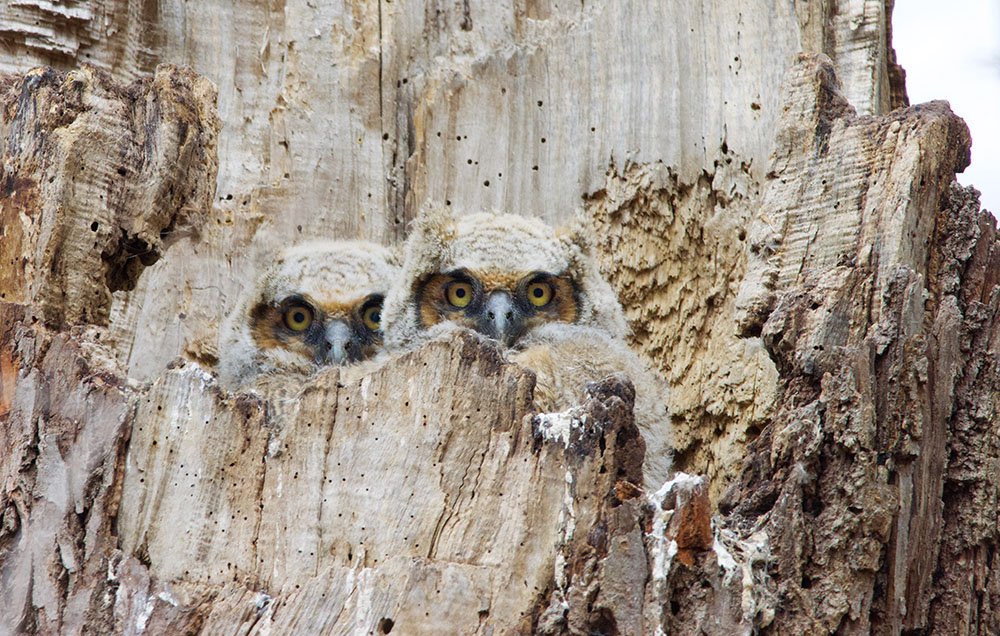
I take the shot, inadequate as it’s likely to be with my paltry 300mm lens. The two little heads bob a bit, then shift their attention as another birder wanders into view on the trail. Every now and then one or another of the birders also shifts their attention to get a shot of the mother owl, perched patiently high in the crown of an enormous tree behind us, perfectly positioned to observe the nest.
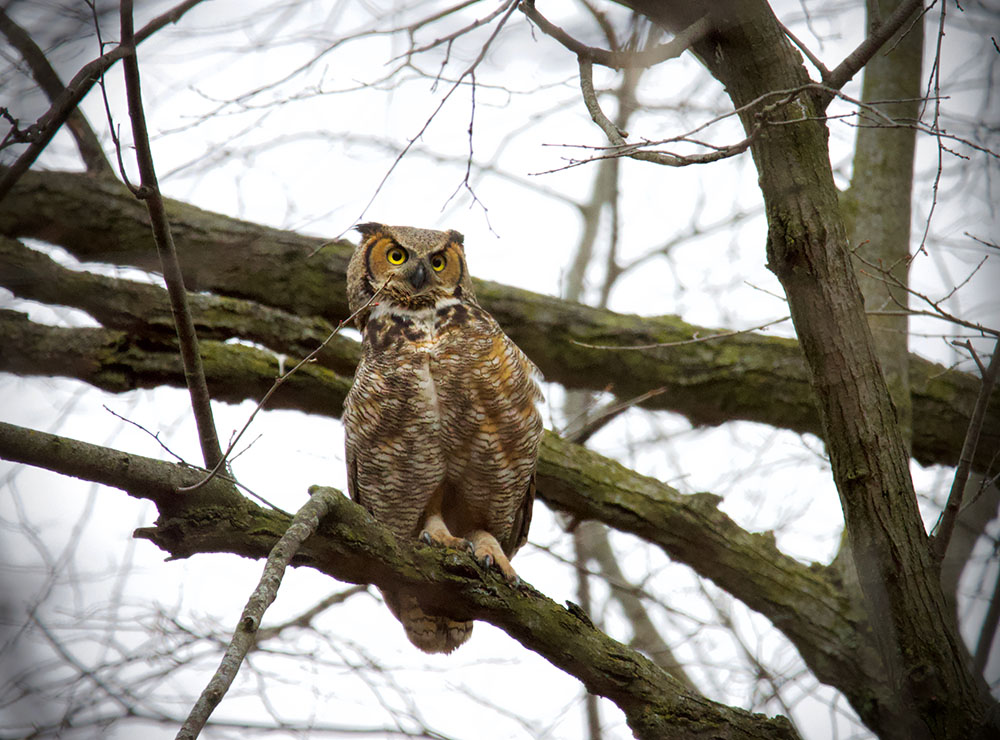
I’ve found my quarry, gotten the obligatory photos; but just when I think I’m finished and ready to count my limited success as a blessing, two men suddenly tramp into our impromptu gathering. One is carrying a long ladder; the other laden with climbing ropes and an assortment of bags and equipment. The birders, startled, react with alarm. Then many breathe a sigh of relief—though a couple remain suspicious judging by their expressions—when one of the men announces that they will be banding the chicks.
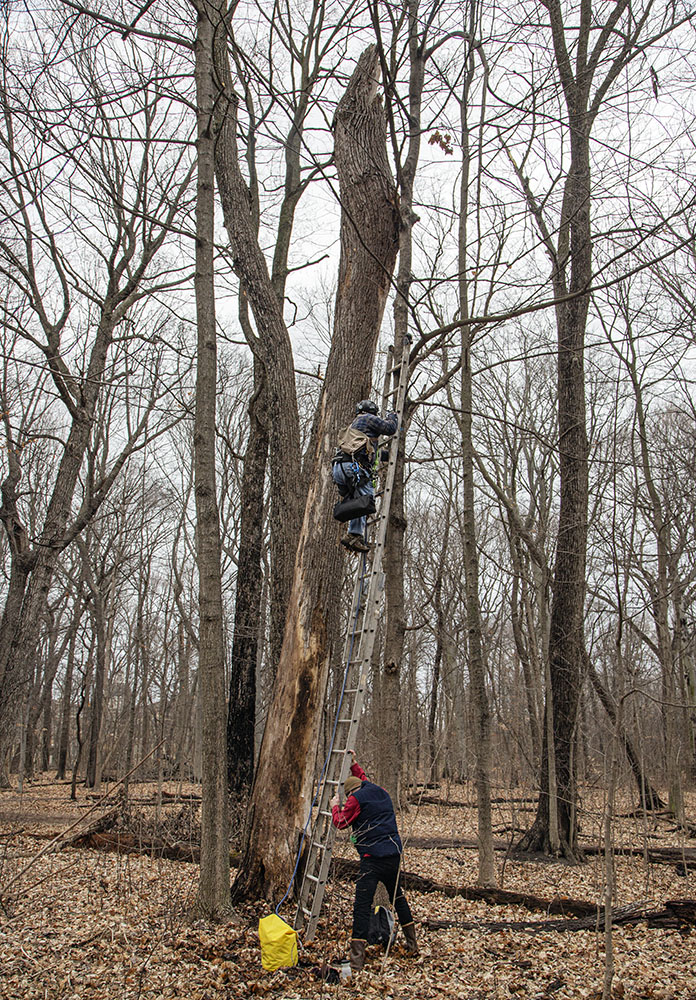
They are both named Bill, they tell us. Bill Stout is an independent wildlife biologist, while Bill Holton is a volunteer assistant. Just as I hear someone muttering to no one in particular, “don’t they need permission for this?” another man, too dapperly dressed for hiking in the woods, strolls up and politely asks to see their permit. He represents the property owner, he tells us. He quickly disappears again after glancing at their paperwork.
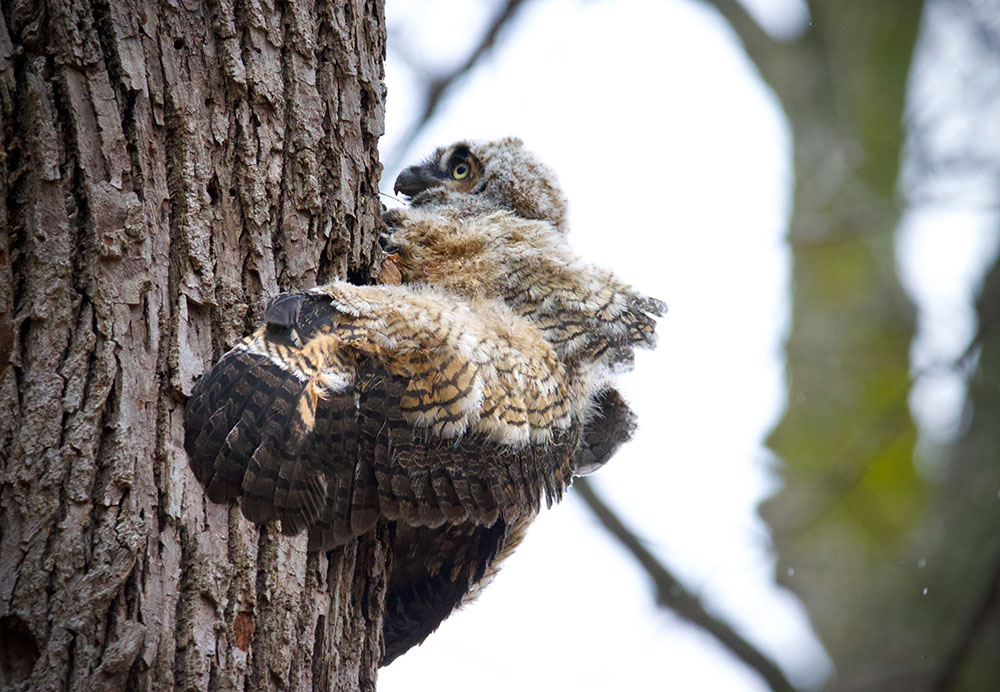
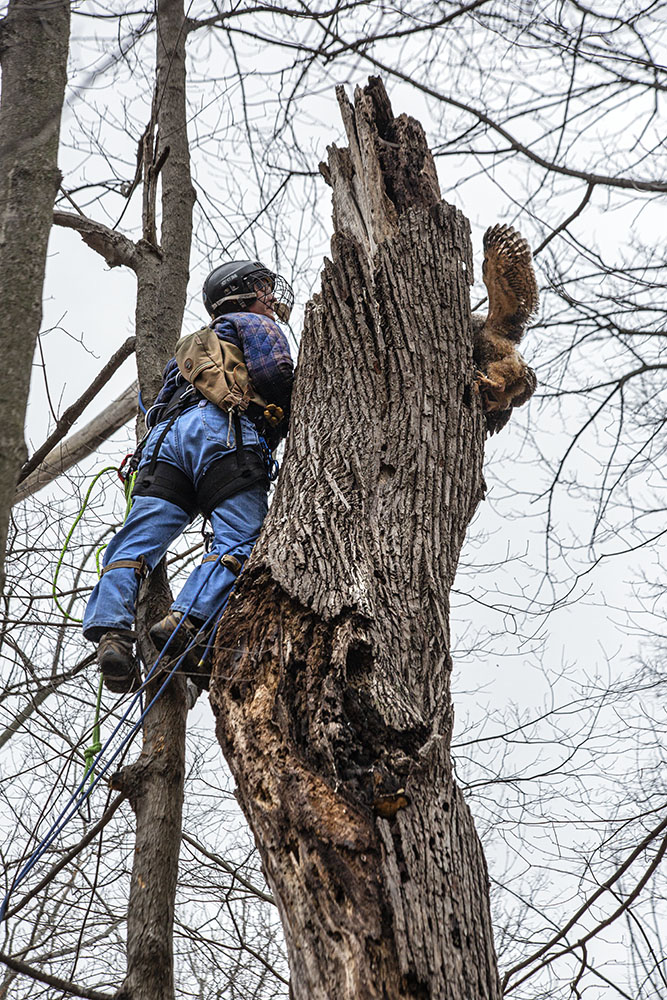
The dead basswood trunk that bears the nest is judged to be too weak to climb but there is a much smaller sugar maple right next to it. The ladder reaches about halfway to the height of the nest. The rest of the way must be climbed. Laboriously. I’ll spare you the details, as it takes about an hour during which progress is measured in inches and each rise marked by cautious repositioning of the safety ropes.
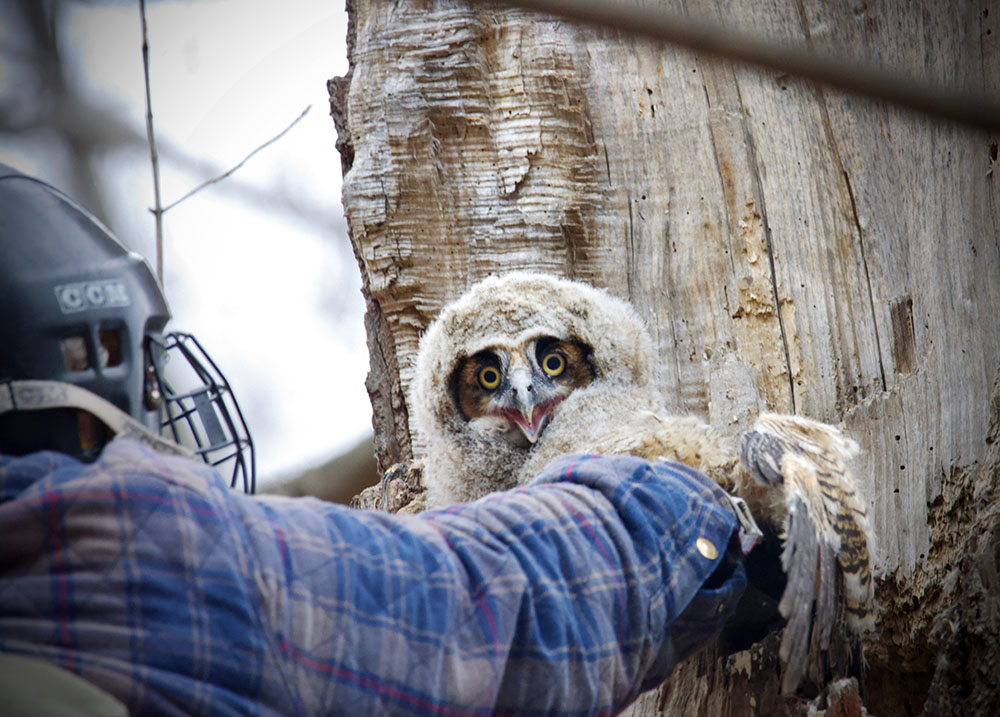
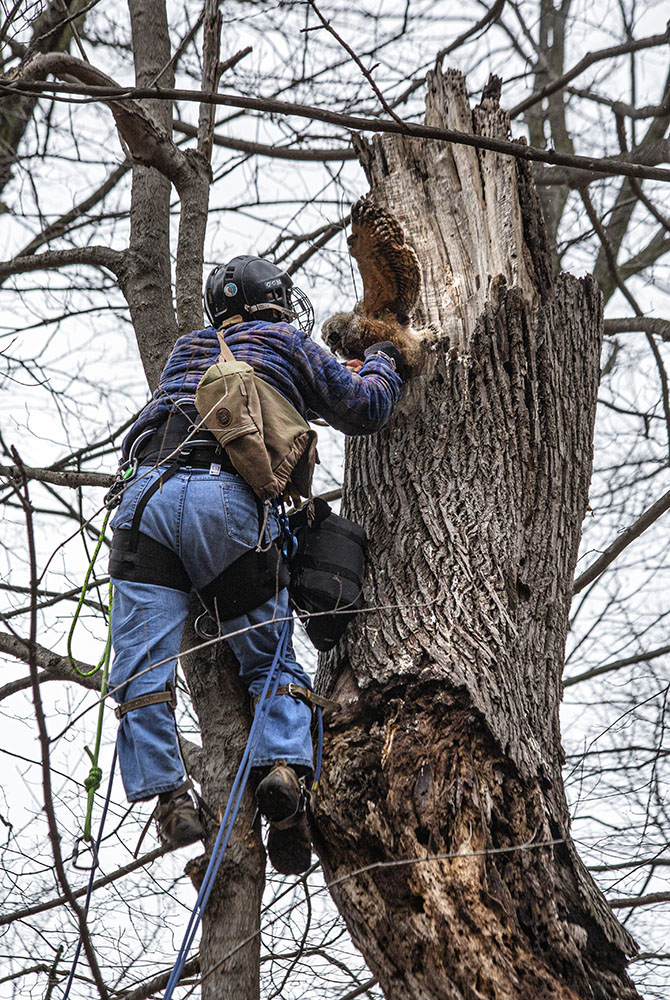
When Bill S. finally reaches into the nest cavity and grabs an owlet, he looks remarkably like a magician pulling a rabbit out of a hat. Spreading her wings with instinctive alarm the “baby” suddenly blooms into an astonishingly large owl. Bill gently gathers the wings together again and slips her into a satchel, like a billowy sleeping bag going into a stuff sack. He lowers the bag into the waiting arms of his assistant on the ground.
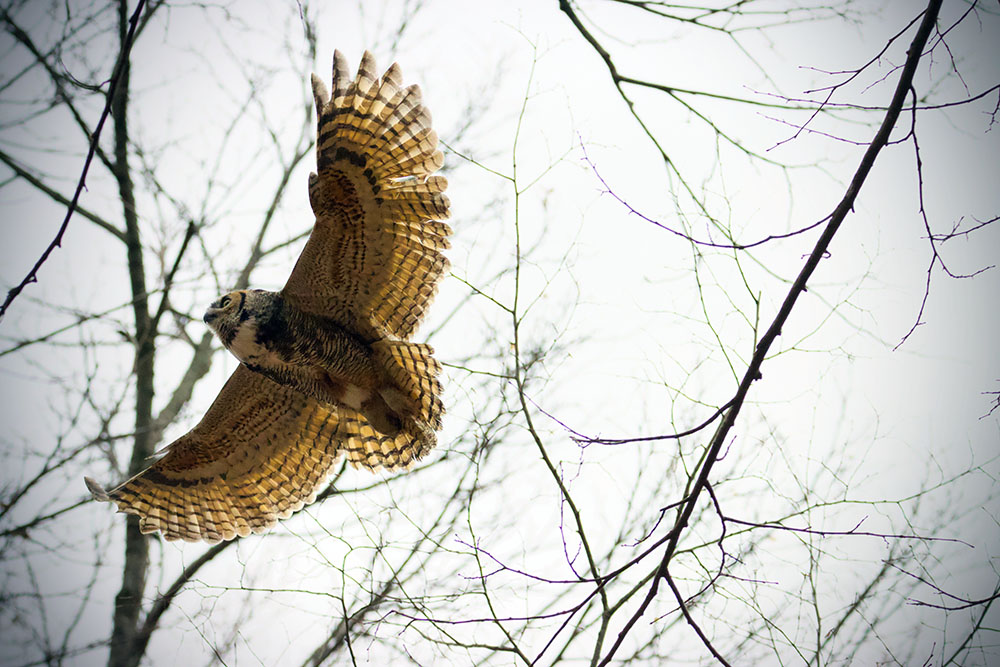
As can well be imagined, as soon as Bill began to climb the tree the mother owl became very alert. By the time he reached the nest she was flying frantically from one tree to another, coming closer and closer. Hence the hockey helmet and mask. Bill, who has been banding since the 1980s, has had plenty of experience that included being attacked with dagger-sharp talons. This time, however, there is no attack.
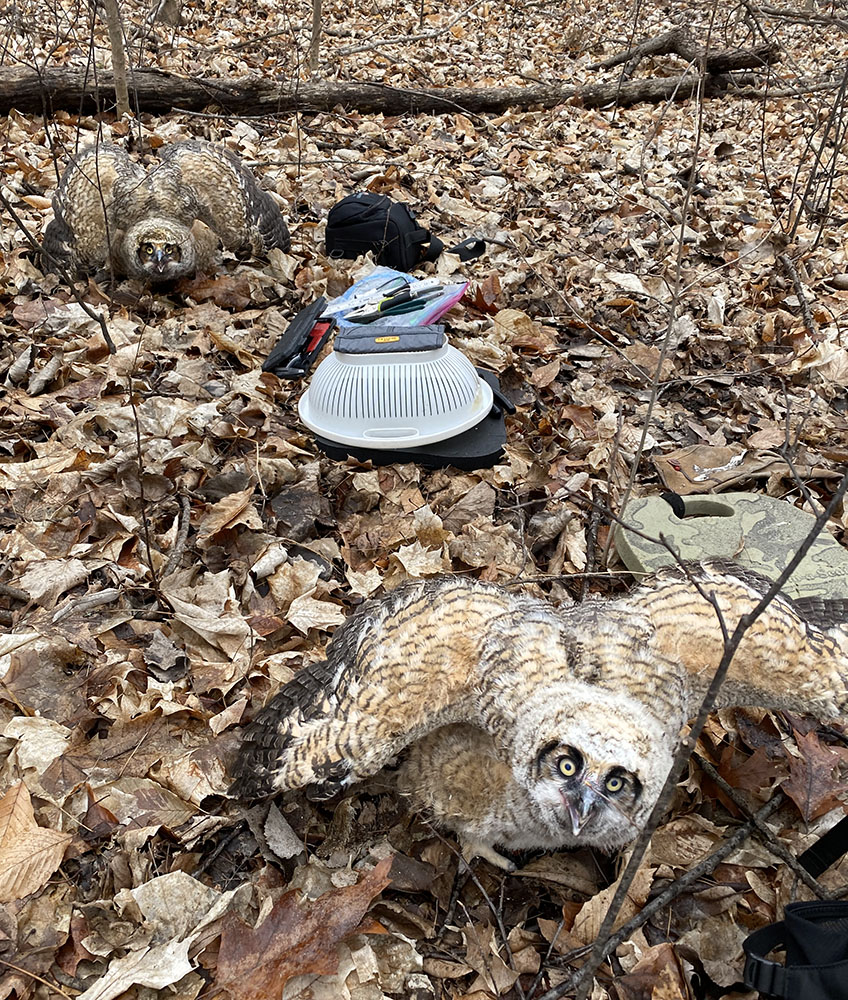
The first two owlets are placed on the ground where the banding equipment has been laid out. They are immediately surrounded by the cadre of birders, causing them to stretch out their wings, erect their feathers and clack their beaks, all natural defensive behaviors. To ease their terror and also to protect birds that have never been away from their nest from cold, drizzling rain that is beginning to fall, one of the women in the circle doffs her down jacket and covers one up. Then she does the same for the second owlet, with an inner, liner jacket, while we all wait for the third owlet to be brought down.

Before descending himself, Bill S. inspects the now vacant nest. Bill H. takes notes as he calls out the animal remains he sees: three headless Norway rats and the rear half of a cottontail rabbit.

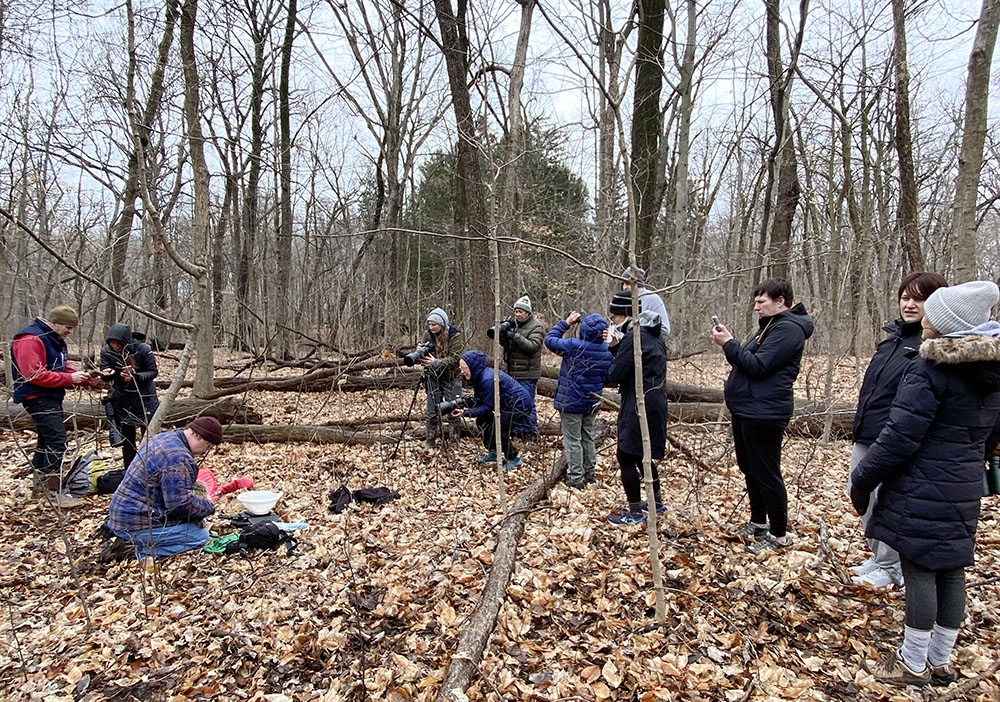
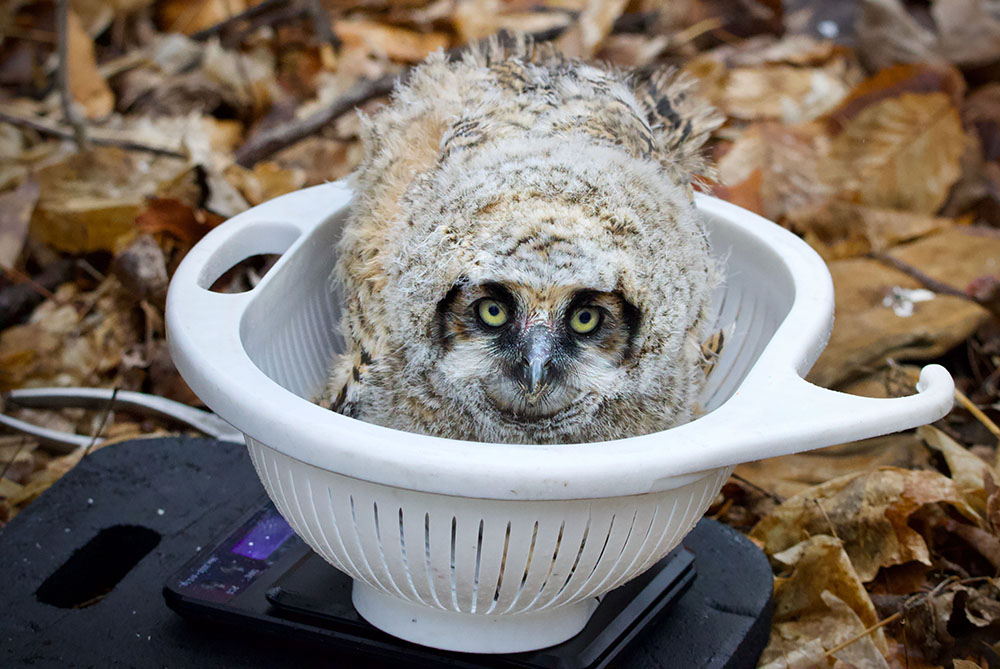
Two hours have elapsed and the group of watchers has nearly doubled by the time the two Bills settle down to do the banding. First, Bill S. takes a number of measurements of each owl in turn, including biomass, fourth primary (part of the wingspan), and tarsus (lower leg) length. A feather sample is collected, which can be used to determine the genetic profile. The data are recorded by Bill H. Biomass and tarsus length can confirm the sex of the birds—guessable by their size. As is typical, the two larger owlets are females; the runt is male. Finally, the small aluminum band is securely (but painlessly) clamped around one of the legs like a loose-fitting bracelet.
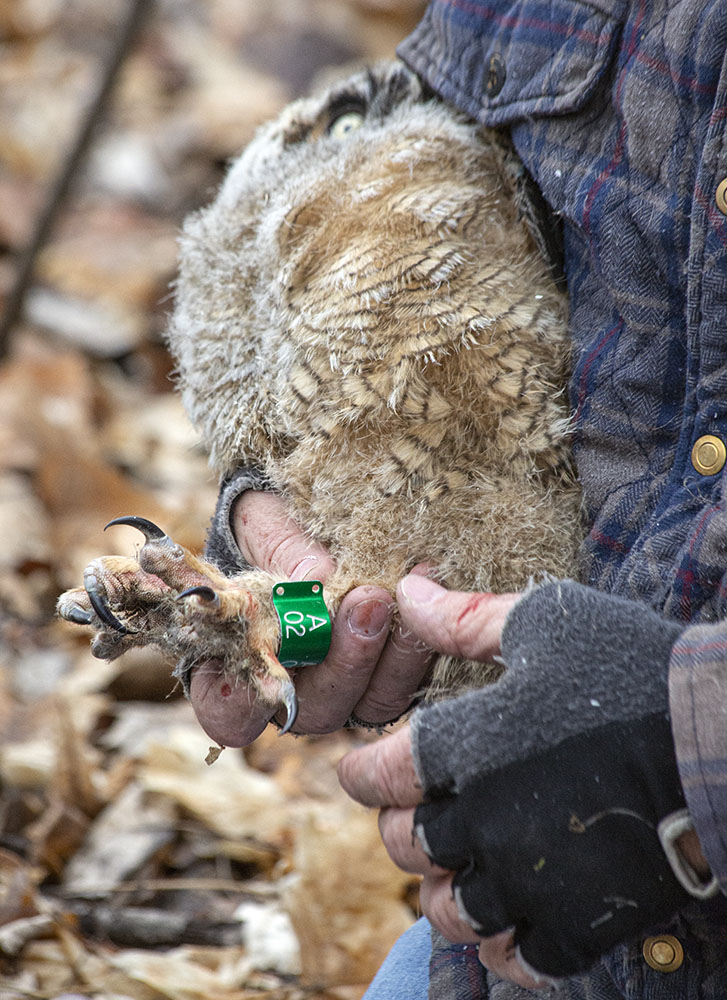
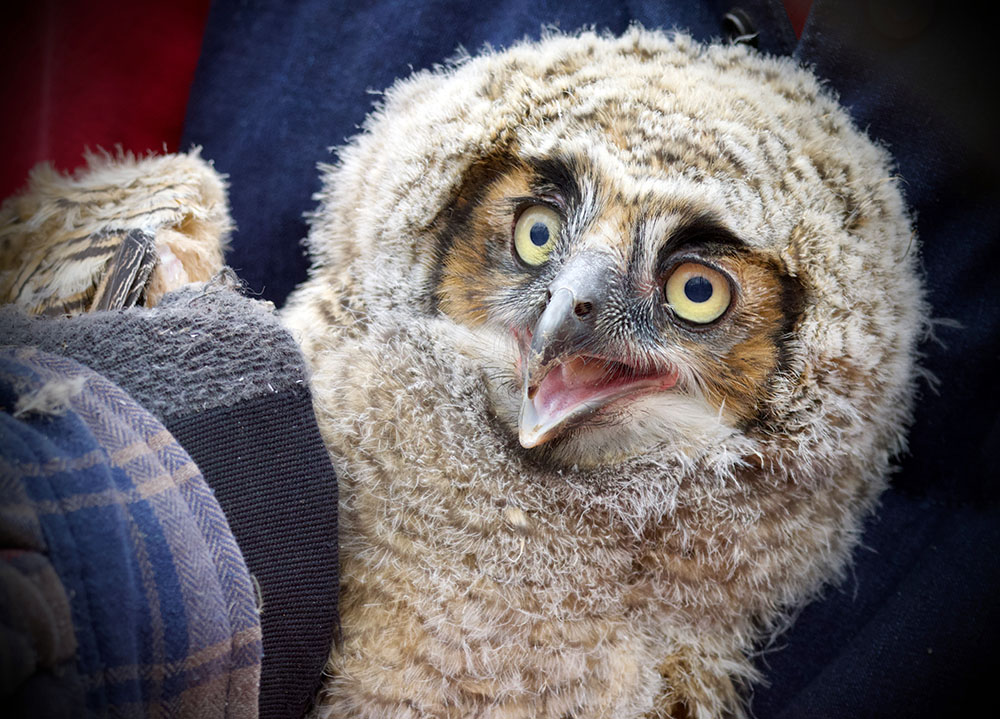
Completing this procedure for all three owlets goes smoothly, but takes quite a while. What, you might well ask, is the mother owl doing all this time? Well, Dad has now showed up as well. Mom takes a break from dashing back and forth above the tableau on the ground to fly off to greet—and copulate with—Dad. What I witnessed wouldn’t have suggested sex to me—just so much more agitation, this time in tandem—but the birders all confirmed it. Mom also flew to the nest and flew off again with the cottontail’s hind quarters dangling from her talons.
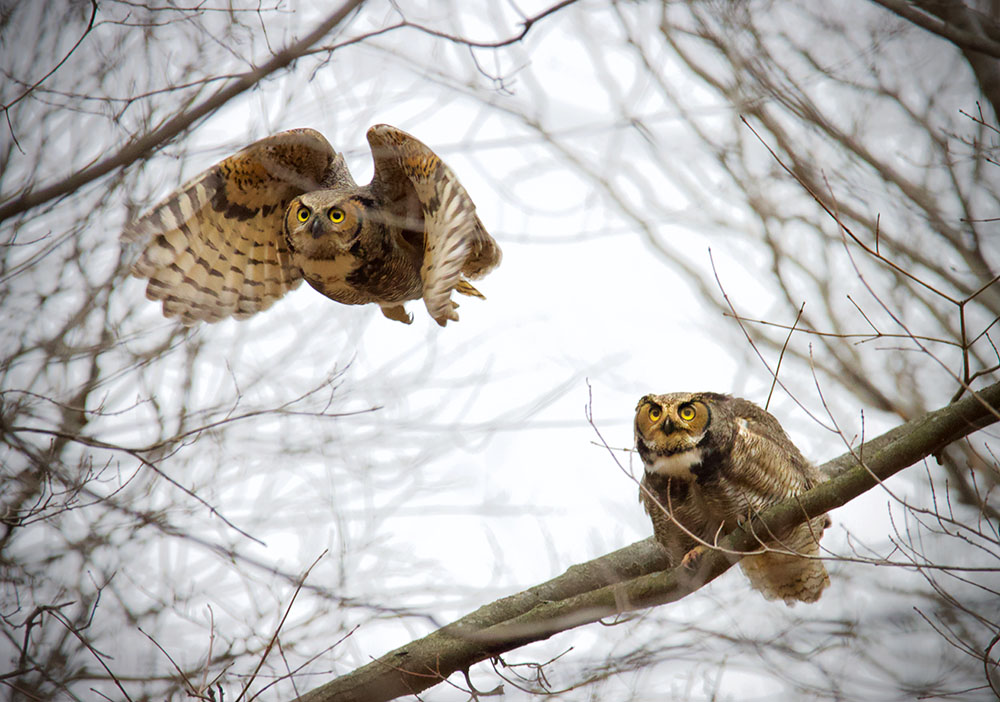
Just when I think we are all done and the birds will be transported back up to their nest cavity, Bill adds another level of excitement to the proceedings by inviting the watchers to hold an owlet. Three take him up on the offer. He demonstrates to each in turn how to safely and securely hold the bird, emphasizing how to grasp the legs in order to control those already formidable talons.
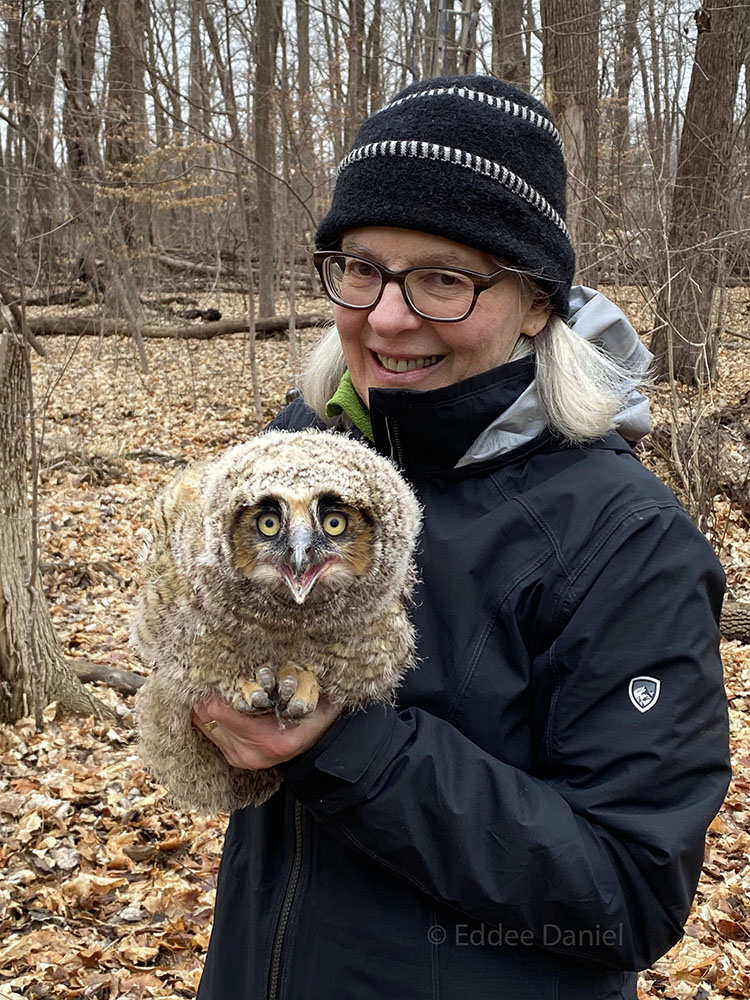
Angie Tornes, a semi-retired National Park Service employee, was one of them. In a follow up email, she reflected on the experience: “Holding the fluffy owlet allowed a thrilling close look at this secretive bird’s incredible beauty. It gave me pause to consider how these handsome animals emerge from healthy woodland habitats and how important it is to conserve these and other natural spaces.”
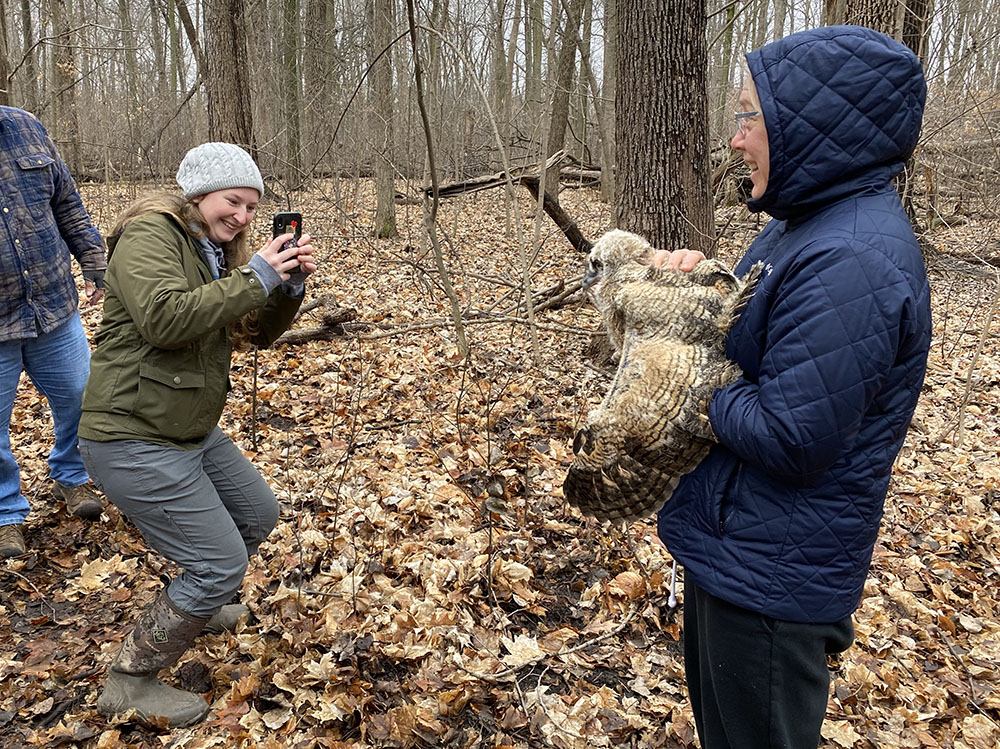
As he begins to wrap up his equipment and prepares to return the owlets to the nest, Bill, the bander and a specialist in Raptor Ecology and Conservation Biology, assures everyone assembled that none of the owls, young or old, are harmed by this process. The purpose of banding, which has been done in the U.S. for over a hundred years, is to study and better understand bird behavior, such as natal dispersal—or where young birds go after they leave the nest. The band contains a unique serial number that identifies each bird, as well as a phone number and address that enables researchers to report a finding.

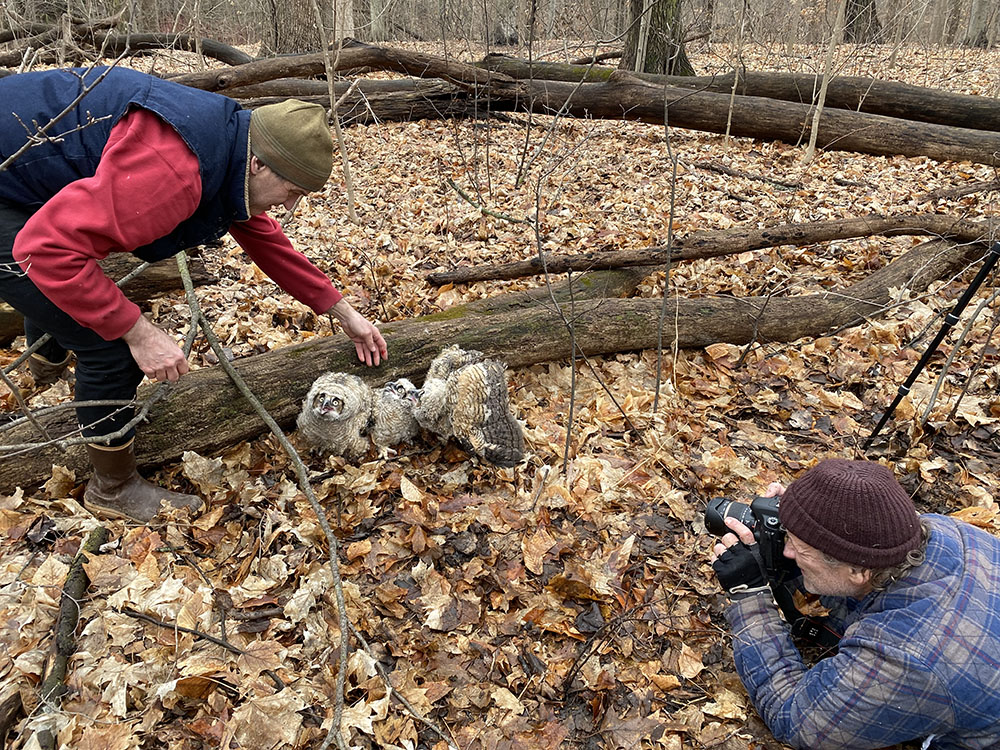
And I am happy, dear reader, to report this finding to you! What a rare find, indeed. I feel blessed and privileged to have stumbled upon and witnessed this event. But I was a mere bystander, surrounded by so many more knowledgeable and experienced birders, some of whom make this (deliberately unnamed) spot a regular stop on their rounds. One of those I met is Elisabeth Melk, who not only witnessed the entire banding episode but has been visiting and recording the adult owls for some time now. Here is what she wrote in a follow up email:
“I have been watching these two adult Great Horned Owls for several months now, well before they even made a nest. It has been amazing to witness the mother incubate the nest and observe the young owls growing up. I am so thrilled to have been a part of the banding process and experience yet another step in the owlets’ journey towards adulthood.”
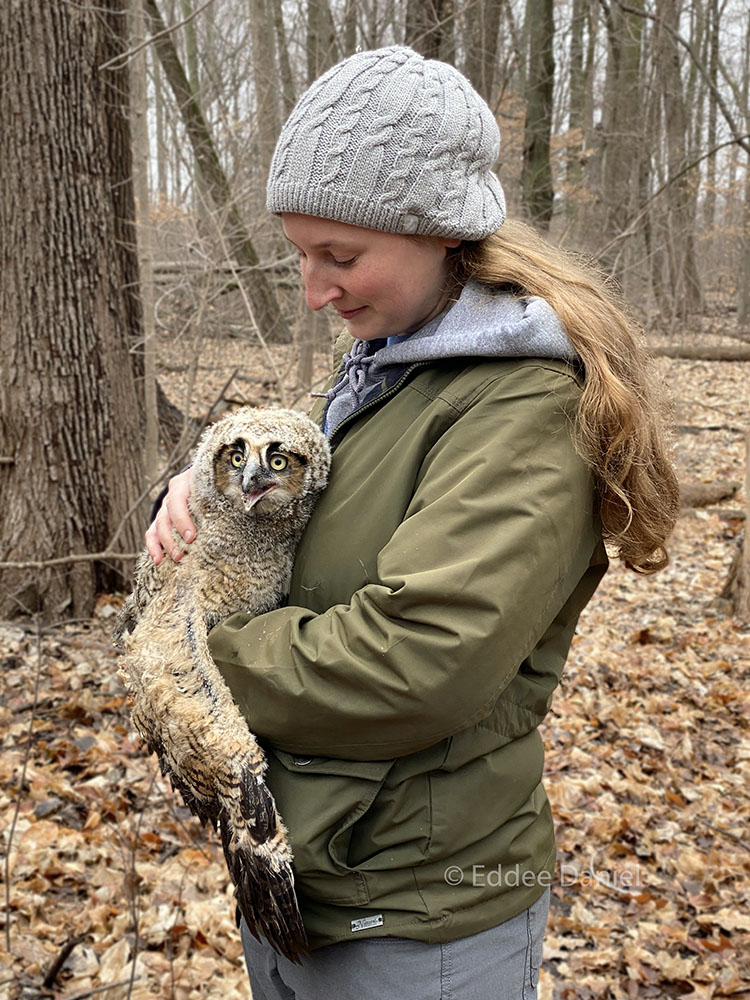
Please note: In order to protect the owls and their habitat, I have deliberately omitted all references to their location. No wild birds should be handled except by those with proper training and appropriate permits.
For more information about banding go to the USGS Bird Banding Laboratory website or the Erie Bird Observatory website.
Related story: It’s been a long time, but I covered bird banding–peregrine falcons–once before in my Urban Wilderness column for Milwaukee Magazine: https://www.milwaukeemag.com/peregrine-falcons-revisited/
Elisabeth (Lizzie) Melk agreed to share a selection of her images, shot with a 150-600mm zoom lens. Lizzie is a self-taught artist and photographer who creates works inspired by wildlife and nature. She attended the University of Wisconsin – Stevens Point for a degree in Wildlife Ecology, during which her passion for wildlife conservation grew exponentially. Lizzie initially took up photography in 2019 as means to gather reference photos for her art. She now thoroughly enjoys the challenges and rewards that photography has to offer, particularly when it comes to birds. Through her artwork and photos, Lizzie hopes to increase in others an appreciation and awareness about wildlife, the environment, and conservation needs. Website: lizziemelkart.
Bill Stout, Independent Wildlife Biologist and bander, provided some of the factual information in a follow up email.
Eddee Daniel is the curator of The Natural Realm. All unattributed photos are his.

